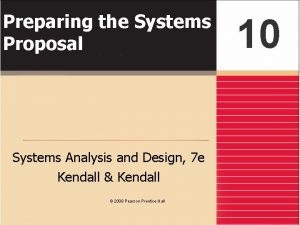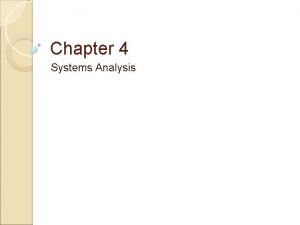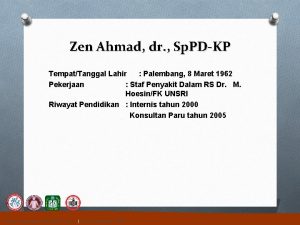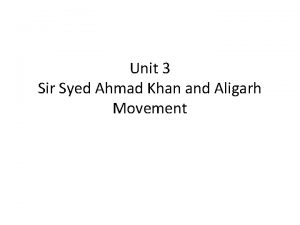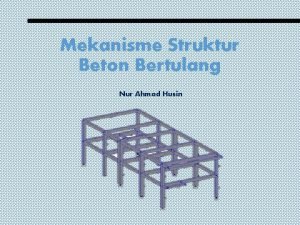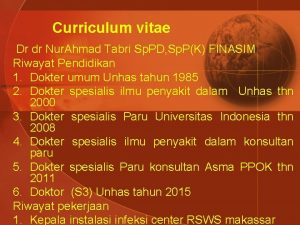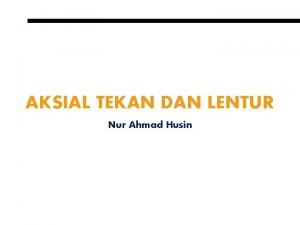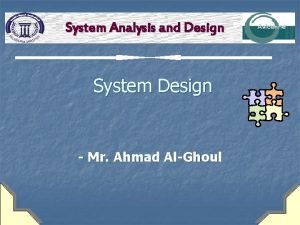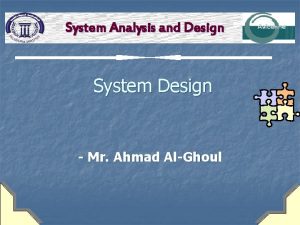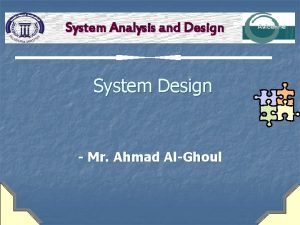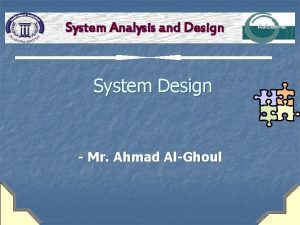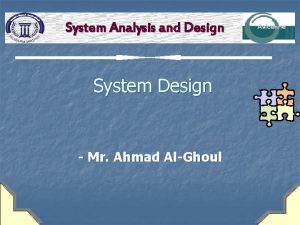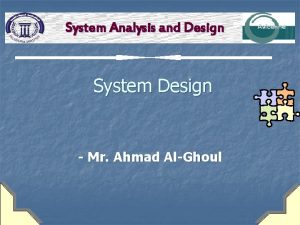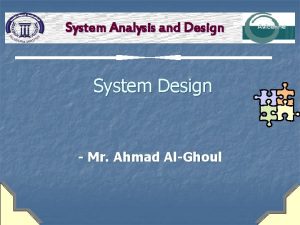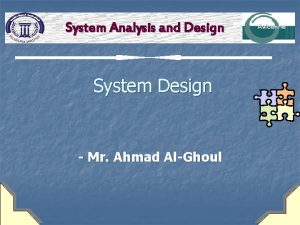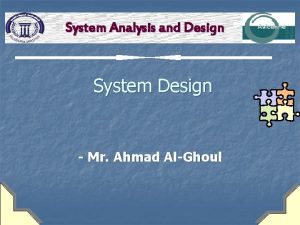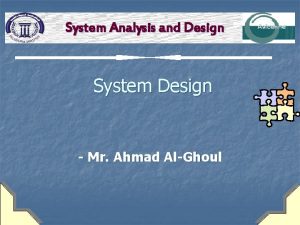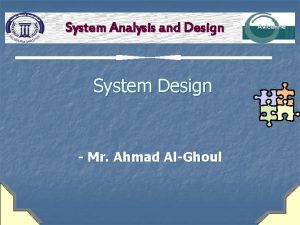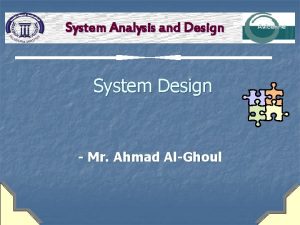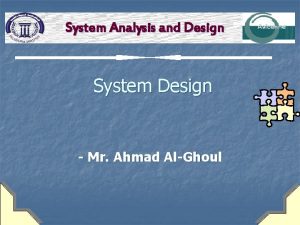System Analysis and Design System Design Mr Ahmad




















![Reference [1] System Analysis and Design, Sixth Edition Authors: Gary B. Shelly, Thomas J. Reference [1] System Analysis and Design, Sixth Edition Authors: Gary B. Shelly, Thomas J.](https://slidetodoc.com/presentation_image_h/0d588cec814f4c4b5281513a4b2a2090/image-21.jpg)
- Slides: 21

System Analysis and Design System Design - Mr. Ahmad Al-Ghoul

Learning Objectives n Design various types of reports, and suggest output controls and security. Avicenna System Analysis and Design System Design 2

Printed and Screen Output n Reports n n n Reports should be attractive and easy to understand Managers sometimes judge an entire project by the quality of the reports they receive Reports must include the information that a user needs Report with too little information is of no value Too much information can make a report confusing and difficult to understand The essential goal when designing reports is to match the report to the user’s specific information needs Avicenna System Analysis and Design System Design 3

Printed Output n Types of Reports n Detail reports: produces one or more lines of output for each record processed n n n Detail line: is any line printed Subtotals and grand totals Control field: controls the output, when the value of control field changes, a control break occurs Control break: A control break usually causes specific actions to occur, such as printing subtotals for a group of records. Control break report: A detail report that focuses on control breaks n The sorting can be done by the report program itself, or in a pervious procedure n Can be quite lengthy n Better alternative is to produce an exception report Avicenna System Analysis and Design System Design 4

Printed and Screen Output n Types of Reports n n A detail report with one printed line per employee. The report shows a simple detail report of employee hours for a chain of retail stores [1] Avicenna System Analysis and Design System Design 5

Printed and Screen Output n Types of Reports n This detail report contains the same data as the report in the pervious slide, but provides much more information. Control breaks are used to separate the data for each store, with subtotals and grand totals for numeric fields. [1] Sub totals Control breaks Grand totals Avicenna System Analysis and Design System Design 6

Printed and Screen Output Types of Reports Exception reports n Displays only those records that meet a specific condition or conditions n Are useful when the user wants information only on records that might require action [1] An exception report that shows information only for employees who worked overtime. Avicenna System Analysis and Design System Design 7

Printed and Screen Output n Types of Reports n Summary reports n Reports used by individuals at higher levels in the organization include less detail than reports used by lowerlevel employees A summary report lists subtotals and grand totals. Avicenna System Analysis and Design System Design [1] 8

Printed and Screen Output n User Involvement in Report Design n n Printed reports are an important way of delivering information to users, so recipients should approve all report designs in advance To avoid problems submit each design for approval as it is completed, rather than waiting to finish all report designs Mock-up: a sample report that the designer should produce for users to review Mock-up should include typical field values and contain enough records to show all the design features You can use word processor, a report generator, or a printer spacing chart to create mock-up report Avicenna System Analysis and Design System Design 9

Printed and Screen Output n Report Design Principles n Printed reports must be attractive, professional, and easy to read n n n Report headers n A report header appears at the beginning of a report and identifies the report as well as the report title, date, and other necessary information. report footers n The report footer, which appears at the end of the report, can include grand totals for numeric fields and other endof-report information. Page headers n n A page header appears at the top of the page and includes the column headings that identify the data. page footers n A page footer appears at the bottom of the page and is used to display the name of the report and the page number. Avicenna System Analysis and Design System Design 10

Printed and Screen Output n Report Design Principles n Column heading alignment n There are several column heading alignment options Four different column heading alignment options. Avicenna System Analysis and Design System Design [1] 11

Printed and Screen Output n Report Design Principles n n n Column Spacing n Space columns of information carefully n Crowded reports is hard to read, and large gaps between columns make it difficult for the eye to follow a line n Column should stretch across the report, with uniform spacing and suitable margins at top, bottom, right, and left Field order n Fields should be displayed and grouped in a logical order Grouping detail lines n It is meaningful to arrange detail lines in groups n Group header: A group header appears above the first detail line of a group. n Group footer: A group footer appears after the last detail line of a group. Group footers could include items such as a subtotal, an average, or a count of the records in that group. Avicenna System Analysis and Design System Design 12

Printed and Screen Output n The Employee Hours report is a detail report with control breaks, subtotals, and grand totals. Notice that a report header identifies the report, a page header contains column headings, a group footer contains subtotals for each store, a report footer contains grand totals, and a page footer identifies the page number. Identifying fields Hours fields Report header Page header Control break Group footer [1] Report footer Avicenna System Analysis and Design System Design Page footer 13

Printed and Screen Output n Report Design Issues n n n n Too much detail is on the page, forcing users to search for the information they need Good design standards produce reports that are uniform and consistent When a system produces multiple reports, each report should share common design elements Constant information does not change when the report is printed Variable information changes each time the report is printed Specify the paper quality, type, and size Label each column of data appropriately After a report design is approved, you should document the design in a report analysis form which contains information about the fields, data types and lengths, report frequency and distribution, and other comments. Avicenna System Analysis and Design System Design 14

Printed and Screen Output n Printing Volume and Time Requirements n n n High volume of reports can significantly increase a system’s TCO Paper is expensive to purchase, print, and store Printed information is outdated quickly Take into consideration printer specific capacity and limitation Efficient printing operations, timely delivery of finished reports, and accurate forecasts of paper and storage needs, all depend on accurate estimates of print volume and times Avicenna System Analysis and Design System Design 15

Printed and Screen Output Control and Security n n Output must be accurate, complete, current, and secure Companies use various output control methods to maintain output integrity and security n Output control includes n n n n Report title Report number report code Printing date Time period covered The end of the report should be labeled clearly Control totals and recorded counts should be reconciled against input totals and counts All processing errors or interruptions must be logged so they can analyzed Avicenna System Analysis and Design System Design 16

Printed and Screen Output Control and Security n Output security protects privacy rights and shields the organization’s data from theft or unauthorized access n Output security includes n n n Limit the number of printed copies and use a tracking procedure to account for each copy You should use specific procedures to ensure that the output is delivered to authorized recipients only Keep sensitive data in a secure place Avicenna System Analysis and Design System Design 17

Printed and Screen Output Control and Security n n n The IT department is responsible for output control and security measures Security should be designed into the system by using passwords and other authentication methods Controlling user access by assigning suitable authorizations and privileges Physical security always will be necessary Many companies have installed diskless workstations n A diskless workstation is a network terminal that supports a full-featured user interface, but limits the printing or copying of data, except to certain network resources that can be monitored and controlled more easily. Avicenna System Analysis and Design System Design 18

Sequence Summary n n n Report can take various types, including detail, exceptions, and summary reports Report Design Principles include report header, report footer, page header, page footer, column spacing, field order, grouping detail lines Output must be accurate, complete, current, and secure Output control includes, report title, report number, report code, printing date, time period covered, and the end of the report should be labeled clearly Output security protects privacy rights and shields the organization’s data from theft or unauthorized access Output security includes, limit the number of printed copies and use a tracking procedure to account for each copy, use specific procedures to ensure that the output is delivered to authorized recipients only, and keep sensitive data in a secure place Avicenna System Analysis and Design System Design 19

Sequence Summary n In this Sequence we have n n Explained various types of reports, including detail, exceptions, and summary reports Explained report Design Principles include report header, report footer, page header, page footer, column spacing, field order, grouping detail lines Explained output control includes, report title, report number, report code, printing date, time period covered, and the end of the report should be labeled clearly Defined and described output security Avicenna System Analysis and Design System Design 20
![Reference 1 System Analysis and Design Sixth Edition Authors Gary B Shelly Thomas J Reference [1] System Analysis and Design, Sixth Edition Authors: Gary B. Shelly, Thomas J.](https://slidetodoc.com/presentation_image_h/0d588cec814f4c4b5281513a4b2a2090/image-21.jpg)
Reference [1] System Analysis and Design, Sixth Edition Authors: Gary B. Shelly, Thomas J. Cashman and Harry J. Rosenblatt , Publisher: SHELLY CASHMAN SEWIES. [2] system analysis and design, sixth edition Authors: Kenneth E. Kendall and Julie E. Kendall Publisher: Prentice Hall Avicenna System Analysis and Design System Design 21
 Principles of computer input and output design
Principles of computer input and output design Structure data tool
Structure data tool Fact analysis in system analysis and design
Fact analysis in system analysis and design Feasibility analysis matrix
Feasibility analysis matrix User interface design in system analysis and design
User interface design in system analysis and design Dialogue design in system analysis and design
Dialogue design in system analysis and design Characteristics of system
Characteristics of system System security in system analysis and design
System security in system analysis and design System proposal in system analysis and design
System proposal in system analysis and design Objective of system analysis
Objective of system analysis Dr zen ahmad
Dr zen ahmad Political services of sir syed ahmad khan
Political services of sir syed ahmad khan Zak ahmad
Zak ahmad Pneumonia severity index
Pneumonia severity index Jawad ahmad md
Jawad ahmad md Nur ahmad husin
Nur ahmad husin Gayatiri
Gayatiri Feigned insanity forensic
Feigned insanity forensic Seitz filter funnel
Seitz filter funnel Dr nur ahmad tabri
Dr nur ahmad tabri Nur ahmad husin
Nur ahmad husin Nur ahmad husin
Nur ahmad husin








